 Missing teeth can cause a variety of problems, from difficulty speaking and eating normally and eventually, poor nutrition. Luckily for people with missing teeth, the world of dentistry has several excellent methods of replacing lost teeth. One time-tested and relatively simple method is the dental bridge. The skilled dental professionals at Nesconset Dental Associates of Nesconset, NY want to take a moment to explain the benefits of bridges for restoring a healthy smile.
Missing teeth can cause a variety of problems, from difficulty speaking and eating normally and eventually, poor nutrition. Luckily for people with missing teeth, the world of dentistry has several excellent methods of replacing lost teeth. One time-tested and relatively simple method is the dental bridge. The skilled dental professionals at Nesconset Dental Associates of Nesconset, NY want to take a moment to explain the benefits of bridges for restoring a healthy smile.
What is a Dental Bridge?
A bridge is a kind of prosthesis (replacement part) that covers the space left by a missing tooth while being supported by the surrounding healthy teeth. In dental terms, the artificial replacement tooth is known as a “pontic” (from the French word “pont” meaning bridge). While the healthy adjacent teeth (abutments) support the pontic on either side. The completed prosthesis crosses spans the gap in your teeth like a bridge crossing over a canyon.
The teeth that will serve as the abutment must be prepared for this role. To do this, they must be crowned or “capped” in much the same fashion as if the teeth needed crowns due to tooth decay or damage.
First, their enamel is removed, in order for the crown to fit over and completely cover the existing teeth while maintaining a lifelike appearance. The crowns on the abutment teeth will support the false tooth (pontic) in between while the pontic is another crown but without a live tooth underneath.
Building a Bridge
As explained above, if you are missing one tooth, your bridge will need three crowns: two for the abutment teeth and one for the pontic in between. This arrangement is known as a three-unit bridge.
If more than one tooth is missing, more crowns (and possibly more abutment teeth) will be utilized to create the bridge. Your dentist must take several variables into account when determining this: the number of teeth missing, the size, length and stability of the abutment teeth and their roots, and also from where in the mouth the teeth were lost.
So if you are missing three teeth, four abutment teeth might support a seven-unit bridge. Engineering and designing the bridge requires not only a working knowledge of the biology of the tooth-supporting gum and bone tissue as well as how to replace teeth.
What to Expect
Getting bridgework completed usually requires two visits to the dentist’s office. At the first visit, local anesthetic will be administered and your abutment teeth will readied as described above. Molds of your prepped teeth will be taken to prepare three-dimensional models of your teeth, used to construct the crowns. A temporary bridge will be placed before you leave the office.
When your permanent bridge is ready, you will return to have it permanently placed placed. You may need some time to become accustomed to the feel of the new bridge against your tongue, lips, and cheeks, but you will most likely forget you even have it eventually.
Caring for your Bridge
Crowned teeth require the same routine care as your other teeth such as brushing twice daily and flossing every day to remove dental plaque. If you have a dental bridge, it is even more important to schedule regular cleanings with your dental provider so that your bridge can last as long as possible.
Dental Bridges in Nesconset, NY
If you live or work in the Nesconset, NY area and would like to discuss tooth replacement options with a skilled professional dentist or even just have a routine teeth cleaning, call (631) 228-8780 or schedule online with your Nesconset Dental Associates dentist today.
